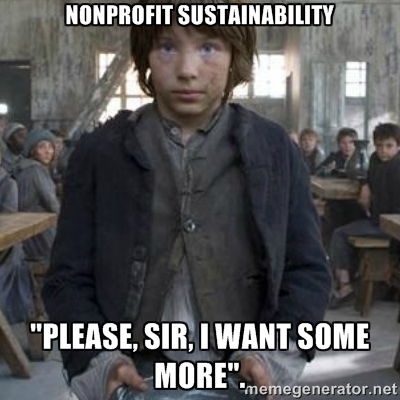 A while ago I wrote “Tips for Not Sucking when You’re on a Panel,” which went viral. (Among us nonprofit bloggers “going viral” means that at least 12 people have read your post). Of course, a panel can have awesome panelists, but if the moderator sucks, then the panel will also likely suck, resulting in disappointed audience members who are now in a bad mood though they can’t pinpoint why. It will also result in panelists who will immediately go to happy hour to drink and talk about what a horrible human being the panel moderator is for wasting their time and expertise.
A while ago I wrote “Tips for Not Sucking when You’re on a Panel,” which went viral. (Among us nonprofit bloggers “going viral” means that at least 12 people have read your post). Of course, a panel can have awesome panelists, but if the moderator sucks, then the panel will also likely suck, resulting in disappointed audience members who are now in a bad mood though they can’t pinpoint why. It will also result in panelists who will immediately go to happy hour to drink and talk about what a horrible human being the panel moderator is for wasting their time and expertise.
Moderating a panel, however, is not like making meth, which I’ve learned in Breaking Bad is actually very complicated and precise. If you are asked to moderate a panel, or if you know someone who will be moderating one, just follow the simple steps below, and you are guaranteed to not suck. There are 12 tips, which may be hard to remember, so I’ve made them into an acronym: TPLFIDPPVCEC
1. First and foremost, Think of the audience. Yes, the unlearned, unwashed masses huddled silently in front of the refined and much better dressed panelists. Seriously, the whole point of the panel is to impart something useful to this lowly group of people. Panelists are just instruments toward that objective. You wouldn’t have a panel if you had no audience, right? You are there to serve the audience first, the panelists second. Always keep that in mind.
2. Prepare. Nothing is as annoying as a disorganized panel, except maybe toenail fungus or children singing in the background of rap songs. Communicate with your panelists so they know the objective of the panel. Read up on their work so that you are knowledgeable when you brainstorm your questions. Give them a few sample questions you may ask. Send reminders as the date approaches, and ask panelists to arrive 30 minutes early. Tell them it’s so that they can meet one another, but it’s actually just a good strategy to minimize lateness.
3. Limit your panelists to 3 or 4 people; 3 is ideal. I was once on a panel with NINE other people. By the time everyone finished their introduction, we had 15 minutes left. It was on a Sunday, too, so there were approximately 18 people in the audience. Fortunately, everyone left inspired, and by that, I mean bitter and angry.
4. Frame the conversation. In your short welcome speech—and make sure it’s short—repeat the objective of the panel. Why is this topic important? What is the problem? What do we want everyone in the audience to leave with? Framing will help everyone stay focused, especially your panelists, some of whom probably didn’t prepare at all and only signed up to be on a panel to avoid real work.
Also, use this framing time to establish some ground rules, including asking panelists to keep their responses to-the-point, and that you apologize in advance but you will cut them off if their answers are too long. It keeps panelists on guard, and it reassures the audience that you are on their side.
5. Introduce the speakers. You wanted them to introduce themselves? Ask a bystander to slap you right now for even thinking of such a thing. Giving panelists time to talk about themselves is tantamount to panel suicide, and I don’t use the term “tantamount” lightly. I’ve seen a panelist go on for 15 minutes about her background, and the moderator did nothing about it. If you introduce people, you can both make the panelists feel important (“Aw, he learned about my work and memorized a fun fact so he could introduce me…”) as well as control the time. If you insist on having panelists introduce themselves, fine, but say something like, “Please introduce yourself in one minute or less. I mean it, one minute.” Then glare at each of them and draw a finger across your neck to ensure they get the message.
6. Ditch the PowerPoint. As a panelist I never use PowerPoint. One, because I’m lazy, but two, because people don’t really want to look at PP slides, because everyone is generally bad at PowerPoint, adding way too much text and having too many slides. And when you have four or five people, each using a PP presentation, the logistics are annoying, and even if logistically everything goes smoothly, people will always go over time limit, limiting time for discussion, and the audience will be snoozing away. There are exceptions, but overall, a simple one-page summary handout will more effectively accomplish almost anything a PowerPoint can do and won’t make your audience members wish for the Mayan Apocalypse to have taken place.
7. Pay Attention. Some moderators feel like they are just there to kick-off the conversation and let the panelists take over until the Q&A section. No, that’s very lazy. As a moderator, your job is to moderate, thus, you are called a moderator…so therefore you should moderate. However, you can’t do that if you are not paying attention. Sit next to the panelists, or maybe in the corner formation (described here in “Feng Shui for Nonprofits, the Seven Basic Meeting Formations”). Have a notebook with you and write down things as panelists talk that you want to clarify or ask follow-up questions to, which we’ll talk about below.
8. Provoke reactions and discussion. You have a bunch of (hopefully) brilliant experts with a (hopefully) diverse set of viewpoints. It is a boring waste of time and opportunity if they don’t interact with one another. Panelists tend to be too polite (unless they read my Tips for not sucking as panelists, in which case they should be getting into fist-fights with one another), so you must force them to interact. You can do this tactfully by summarizing and asking for counter-opinions, e.g., “John: Susan said that parental engagement is THE key factor in student achievement. You had mentioned earlier that you were a terrible student. I think Susan may have insulted your mother. How do you respond to that?”
9. Varietize. Too many moderators have the “assembly line” format, where they ask a question, then panelists go down the line answering. Usually by the time the third person speaks, half of the audience has tuned out. By the time the fifth person speaks, 75% of them have entered some sort of trance-like state where they are daydreaming about inventing a time machine to go back in time and prevent their parents from meeting so that they wouldn’t be born and thus would not have to attend this panel.
Assembly line is fine once a while, especially if your questions are good, but don’t keep using it. Call on different people for different questions. Ask panelists to rank or prioritize things and defend their positions. Point out potential disagreements. You must be on your toes to do all of that, but the audience and panelists will get a lot more out of it.
10. Cut off long-winded speakers. A major, in fact probably most important, job of the moderator is to intervene when panelists are off track or rambling. If you followed Tip #4 and framed the conversation right, it will help people to not be offended. Now it’s just a matter of politely jumping in with things like, “I’m sorry for cutting you off, John, but I’d like to get the other panelists’ viewpoints before we move to the next questions” or “John, it seems like you have a lot of valuable insight on this topic, but we have several questions left and I want to make sure we get your perspective on those questions too” or “John, excuse me…John? Hey, John…listen…can you…I’m sorry for…John, just shut up! Shut up, John!” It’s uncomfortable to have to do that, but that’s your job.
11. Engage the audience. If you watch talk shows, notice how skillful they are at engaging the audience. Audience members are asked to participate in everything. On The Doctors, they pull audience members up to feel fake mucus in an enlarged sinus. I think that’s what I saw once. Talk shows know that without the audience, there is no show. Depending on how big your audience is, you may want to do things like ask people to briefly introduce themselves, do a quick ice breaker (here are some icebreakers that don’t suck), have small-group discussions, raise their hands for various questions, come up to feel fake snot, etc. Then leave plenty of time for Q&A, since an engaged audience will have more questions.
12. Conclude with practical take-aways/advice. Do not ask your panelists to go down the line summarizing what they just said, or to conclude with some final words of wisdom or something. Chances are, the panelists will waffle something incoherent. Best to end with something like “What is something concrete the audience members can do today to blah blah” or “what are three practical pieces of advice you have for our audience for blah blah” or “In one word, what do you think will solve the problem of blah blah.” Don’t actually say “blah blah.” Replace it with the relevant topic. (Although, blahness is a really big problem in the world)
Get those 12 tips down and you should be a pretty decent panel moderator. Just remember TPLFIDPPVCEC. Leave additional tips in the comment, and please forward this list on to your panel moderating friends.
PS: Bonus tip: Reconsider giving panelists mugs as a thank-you (I have eight from panels). We don’t expect any gifts, but if you are going to give a small token of thanks, here are some acceptable items: Movie tickets, gift cards to local coffee shops, or bars of dark chocolate (at least 65% cocoa). Mugs are fine, but maybe fill them with whiskey first.
 Hi everyone. For the first time in my eight years with the organization, my board has decided to conduct a performance review. These are two words that send chills up and down every Executive Director’s spine, on par with “budget deficit” and “annual event.” The board had a clandestine meeting three weeks ago to talk about my performance as an ED. Soon they will meet with me to deliver feedback.
Hi everyone. For the first time in my eight years with the organization, my board has decided to conduct a performance review. These are two words that send chills up and down every Executive Director’s spine, on par with “budget deficit” and “annual event.” The board had a clandestine meeting three weeks ago to talk about my performance as an ED. Soon they will meet with me to deliver feedback.






